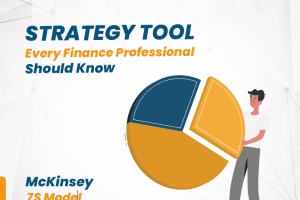
Strategy Tool Every Finance Professional Should Know: Business Model Canvas | Weekly Strategy Bites
📌 Weekly Strategy Bites Post
The Business Model Canvas is a strategic tool that helps organizations create, deliver, and capture value effectively. By mapping out key elements of a business, it provides a clear structure for decision-making and ensures alignment with market needs.
Using this framework, businesses can streamline operations, enhance their value proposition, and stay competitive in a dynamic market.
The Strategic Framework for Value Creation
The Business Model Canvas is a powerful strategic tool that helps organizations visualize, assess, and transform their business models. This comprehensive framework enables finance professionals to understand how their organization creates, delivers, and captures value through nine essential building blocks.
The 9 Building Blocks of Business Model Canvas
1. Key Partners
Identify the strategic alliances that optimize your operations, reduce risks, and provide competitive advantages. These partnerships form the foundation of your business ecosystem and supply chain relationships.
2. Key Activities
Outline the most crucial activities required to implement your value proposition effectively. These are the primary operations that drive your business forward and deliver value to customers.
3. Key Resources
Document the essential resources—human, financial, physical, and intellectual—needed to create value for your customers. These assets are fundamental to your ability to deliver your products or services.
4. Value Propositions
Define the products and services you offer to meet customer needs, including your unique selling proposition that differentiates you from competitors. This is the core of why customers choose your business over others.
5. Customer Relationships
Determine the type of relationships you want to establish with each customer segment and how you’ll interact with them throughout their journey with your business.
6. Channels
Map out the various pathways—whether owned or through partners—that you use to deliver your value proposition to targeted customers. This includes communication, distribution, and sales channels.
7. Customer Segments
Identify which specific customer groups you aim to serve, segmented by characteristics such as age, gender, location, interests, and habits. Understanding your audience is crucial for targeted value delivery.
8. Cost Structure
Estimate your key cost drivers and planned expenditures across areas like product development, marketing, sales, and operations. This provides clarity on financial requirements and potential efficiencies.
9. Revenue Streams
Project your primary revenue sources and how much you expect to earn from each. This helps in understanding the financial viability of your business model and identifying opportunities for growth.
Why Finance Professionals Need This Tool
For finance professionals, the Business Model Canvas offers a structured approach to understanding the financial implications of business decisions. By visualizing how different elements interact, you can identify opportunities for cost optimization, revenue enhancement, and strategic investments.
This framework transforms abstract business concepts into tangible components that can be analyzed, measured, and improved—making it an invaluable tool for financial planning, analysis, and strategic decision-making.
Are you leveraging the Business Model Canvas in your financial strategy? Start mapping your organization’s building blocks today to unlock new insights and drive strategic value.
#StrategyBites #BusinessModelCanvas #Leadership #ExecutiveEducation #Strategy #Hoftacademy
Tag:Strategy, Strategy Bits



